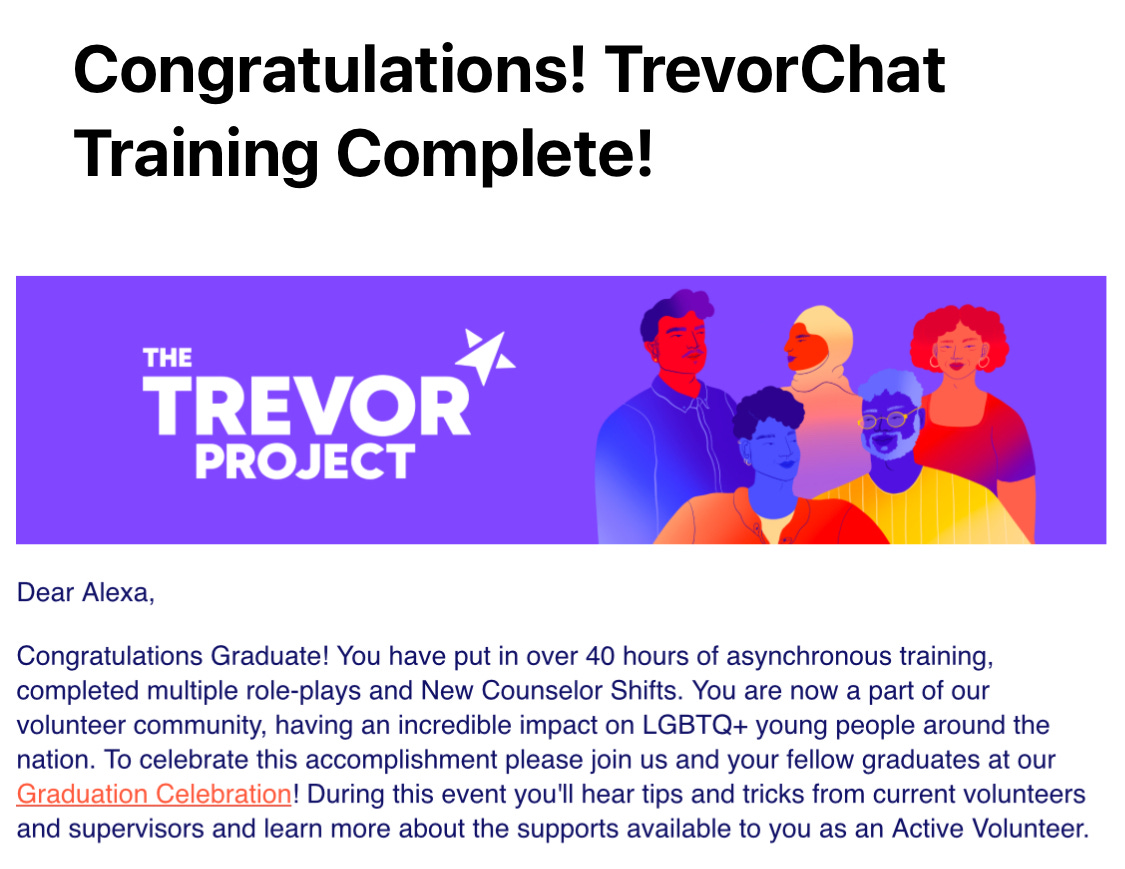27. On holding space
What I’ve learned from my work as a volunteer crisis counselor, and how you can use it to help others and show up as a better partner, family member and friend.
TW: this newsletter discusses the topic of suicide and suicide prevention. If that topic feels overwhelming for you right now feel free to skip it. Take care of yourself, first and foremost.
Also please be aware that I am NOT a mental health professional. This is based on my personal experience as a volunteer crisis counselor but should not replace medical advice.
If you or someone you know is struggling right now you can reach out to The Trevor Project or 988 Suicide and Crisis Lifeline, both are available 24/7.
In an honest conversation last week someone suggested perhaps I was spending too much time focused on my own mental health, to my detriment. Is it possible to be overly invested in your emotional wellbeing? By paying constant attention to your feelings are you giving them too much priority/space and therefore subjecting yourself to their whims? Is there such a thing as self-analysis paralysis?
It’s certainly possible.
Whenever I find myself caught up in my feels, the antidote that most commonly offers relief is to turn the attention around and focus on others.
For me, that has shown up most strongly in my work as a volunteer crisis counselor with The Trevor Project. The skills that I’ve learned through this experience have been invaluable in my own healing journey (side note: I hate that phrase. Healing journey. Ugh, it’s so cringe. If you have something better, please share), and seem worthy of sharing with a broader audience. Read on for what I’ve learned so far, and how you can use it to help yourself or someone in your life. I’ll also share some external resources at the bottom of this newsletter. If you or someone you know is struggling with mental health, I hope this is helpful.
I first learned about The Trevor Project three years ago and resonated instantly with their mission to end suicide amongst LGBTQ+ youth (more than 1 in 10 LGBTQ+ young people attempted suicide in the last year according to Trevor’s 2024 survey). I started donating money and recently found a screenshot on my phone of the volunteer portion of their website from April 16, 2021. I knew then that I wanted to volunteer with the organization, but it would be another 870 days before I finally applied for the position, and almost three full years before I graduated training and started volunteering as a crisis counselor.
(This was yet another lesson in divine timing. I wouldn’t have been able to be a Trevor volunteer in 2021, or 2022. I didn’t have the bandwidth, the brain space or the emotional availability to take on this kind of work. I had to make space in my life to welcome this opportunity in. Good reminder that sometimes the universe is playing the long game, and you just have to stick it out.)
I started my Trevor training beginning of this year and instantly saw how intense it was going to be. The role of a crisis counselor is to answer text/chats from young people in crisis who reach out to Trevor for support (there is a call option as well but let’s be real, kids these days mostly want to text). The youth are often experiencing suicidal ideation or dealing with very intense emotions and trauma and it’s our job to help them through it. It’s heavy but rewarding work.
In our very first informational session, they hosted a Q+A and I asked a question that I knew was on a lot of people had on their minds: will we ever find out what happens to these kids? Will we get to talk to them again, or get any sort of closure on their situation?
The answer is no.
Most of the time we don’t know how their journey ends. We just have to do our best to be there for them in the moment. That was a tough pill to swallow in the beginning.
I had some friends and family who were concerned about me taking on this role when I was already in a somewhat fragile mental state myself. “Are you sure it’s not going to be too much?” was a question I got more than once. Self-doubt flickered but ultimately, I was resolved. Deep down I knew that this work would not only help others but also help myself.
I persevered through 10 weeks and 40 hours of training that included self-guided modules, group Zoom calls where we practiced our skills and role-plays. After passing my Capstone role-play and completing my New Counselor Shifts, I officially graduated as a Trevor volunteer crisis counselor. It is hands down one of my most proud accomplishments.
So what did I learn and how exactly is it relevant? Keep reading.
1. Use Correct Language
First and foremost, it’s important to be aware of the correct, people-first language to use when talking about suicide. Words matter. We want to avoid words like “committed” or “successful/unsuccessful.” By using people-first language we’re separating the person from their condition, reinforcing the fact that their condition does not define them. The same can be used for other mental illnesses i.e. “He has / is living with schizophrenia” vs. “He’s schizophrenic.” I found this guide incredibly helpful.
Same goes for pronouns. Share yours. Ask others. Use them correctly. Get comfortable using they/them as a default. It matters.
2. Hold Space
The main thing that I’ve learned from my time at Trevor is that the best, most helpful thing you can do for people is just to hold space. When a loved one comes to us with a problem, we often jump to giving advice or wanting to “fix” it for them. We rush to say, “Well when this similar thing happened to me, I did...” or “If I were you I would...” I’m 100% guilty of this. Part of this reaction is that we just want to relate to the person and their situation, and we don’t want to see our loved ones in pain, so our brain automatically goes into problem-solving mode. This is especially difficult for us doers and over-achievers.
And yes, in some situations your loved one might specifically ask for advice, but often what they need is just a safe space to voice their feelings. Holding space is about listening and listening without judgement. Less is more, in this case. Let them do the talking and give them space to explore what’s going on without inserting yourself.
3. Ask Open Ended Questions
So how do you hold space for someone? One of the easiest ways is by asking open-ended questions. This keeps them talking and keeps the conversation focused on the other person (instead of bringing it back to yourself).
What brought on these feelings?
How did it feel when ___?
How are you feeling now?
How long have you been feeling ___?
What happened next?
What’s your relationship with ___ like?
Who else have you been able to talk to about this?
Tell me more about ___?
What are your fears/concerns about ___?
What do you think would happen if ___?
4. Validate and Normalize
Once someone has shared their feelings with you the next best thing to do is validate and normalize those feelings, again without trying to “fix” them.
I can totally understand why you feel that way.
It makes a lot of sense that you’re feeling ___.
That must be really difficult for you.
That sounds really hard.
Feeling like ___ must be so ___.
It’s totally okay to feel that way. You deserve ___.
You’re not alone in feeling ___.
5. Avoid Pity
This one was really hard for me in the beginning. Trevor explicitly directs us counselors to avoid saying “sorry” in conversation with youth in crisis. When someone shares something traumatic my brain automatically jumps to wanting to say something like, “Wow, that’s horrible, I’m so sorry that happened to you.”
Why no “sorry”? In this context, saying sorry may be interpreted as having pity for someone or their situation. This could make it seem like we are looking down on them rather than standing side-by-side with them in support and make them feel like even more of a victim. Instead, I’ll answer these kinds of exchanges with phrases like, “That sounds so hard. You don’t deserve to be treated that way.” This acknowledges the difficulty of their situation without reinforcing the feelings of victimization.
These tools aren’t just for conversations about suicide. I’ve noticed a significant change in my own interpersonal relationships since going through this training and I'm more consciously aware of how I show up as a partner, friend, sister and daughter in everyday conversations.
Here are some other resources to check out or share with loved ones:
The Trevor Project https://www.thetrevorproject.org/resources/
Mental Health First Aid https://www.mentalhealthfirstaid.org/mental-health-resources/
National Institute for Mental Health https://www.nimh.nih.gov/health/find-help
CDC Mental Health https://www.cdc.gov/mentalhealth/tools-resources/index.htm
Plus there are so many different mental health apps/companies now, it’s honestly overwhelming. Check out meditation apps like Calm, Headspace, Insight Timer, Breathwrk, Open or therapy/support group apps like BetterHelp, TalkSpace, Rula, ShareWell etc. **I’ve used/tried all of these personally, otherwise I wouldn’t recommend them!
What did I miss? Let me know in the comments!
Also, a friend recently asked me how I found my therapist, does this topic interest you? If yes let me know and I will talk about my process in an upcoming newsletter.
It’s not easy being a human in this world. We can often get trapped in our own thoughts, our own patterns, and spiral off into unlikely disaster scenarios. But I’ve found that the number one best way to get out of your own head is to help someone else. By being a supportive friend or partner and lifting others up we build community and actually release endorphins that help us feel better too. It really is a win/win.
As Mark Duplass (my current mental health hero) says, “Sending you a 100 foot wave of hope.”
Until next time, thank you for being here.







🫶🏾
Alexa. This is so special. Thank you for sharing about this and your training. You’re so right. These are skills we could all stand to know and utilize in the day to day and especially in a crisis. 🖤
And yes, please write about how you found your therapist. I’m always interested in how this comes about for others.